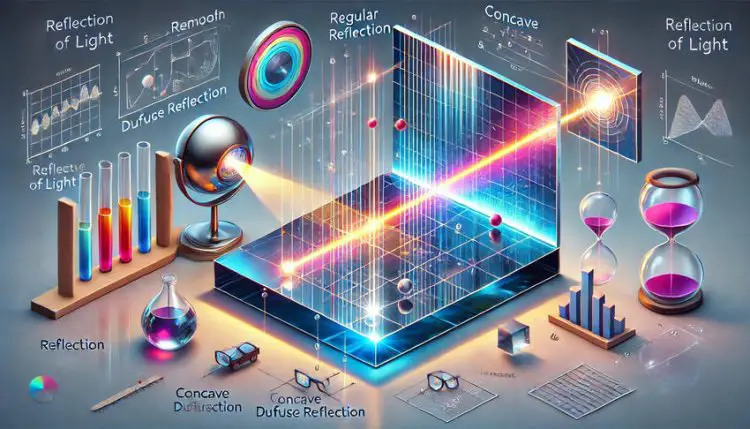Light – Reflection and Refraction
Light is a fascinating phenomenon that interacts with matter in various ways, including reflection and refraction. This article delves into the principles of light reflection, exploring the laws of reflection, types of reflection, and the behavior of spherical mirrors. Additionally, it explains the concept of refraction, including the laws of refraction, refractive index, and the behavior of spherical lenses. Discover how light bends and bounces off surfaces, and how spherical mirrors and lenses manipulate light to form images. Learn about the mirror and lens formulas, sign conventions, and the power of lenses. This comprehensive guide provides a detailed understanding of light reflection and refraction, essential for understanding various phenomena in physics, optics, and engineering.

Reflection of Light
Reflection is the phenomenon where light rays bounce off a surface. The laws of reflection state:
- The angle of incidence is equal to the angle of reflection.
- The incident ray, the reflected ray, and the normal to the surface all lie in the same plane.
Types of Reflection:
- Regular Reflection: Occurs on smooth surfaces, where parallel incident rays remain parallel after reflection.
- Diffuse Reflection: Occurs on rough surfaces, where parallel incident rays are scattered in different directions.
Spherical Mirrors: Concave and Convex
Spherical mirrors have curved surfaces that form part of a sphere.
Concave Mirrors:
- Curved inward, like the inside of a sphere.
- Principal Axis: The line passing through the center of the mirror's surface and its center of curvature.
- Focus (F): The point where parallel rays converge after reflection.
- Focal Length (f): The distance between the mirror's pole (P) and the focus (F). For concave mirrors, it is positive.
Convex Mirrors:
- Curved outward, like the outside of a sphere.
- Focus (F): The point from which parallel rays appear to diverge after reflection.
- Focal Length (f): For convex mirrors, it is negative.
Mirror Formula
The mirror formula relates the object distance (u), image distance (v), and the focal length (f) of a spherical mirror:
1/f = 1/v + 1/uSign conventions:
- All distances are measured from the mirror's pole.
- Distances measured in the direction of incident light are positive.
- Distances measured against the direction of incident light are negative.
Refraction of Light
Refraction is the bending of light as it passes from one transparent medium to another due to a change in its speed.
Laws of Refraction:
- The incident ray, the refracted ray, and the normal to the interface all lie in the same plane.
- The ratio of the sine of the angle of incidence (i) to the sine of the angle of refraction (r) is constant (Snell's Law):
sin i / sin r = constantRefraction through a Rectangular Glass Slab
When light passes through a rectangular glass slab:
- It bends towards the normal when entering the denser medium (glass).
- It bends away from the normal when leaving the denser medium.
- The emergent ray is parallel to the incident ray but is laterally displaced.
Refractive Index
The refractive index (n) of a medium is the ratio of the speed of light in vacuum (c) to the speed of light in the medium (v):
n = c / vIt can also be defined using Snell's Law:
n = sin i / sin rRefraction by Spherical Lenses
Lenses are transparent objects with at least one curved surface that refract light. There are two main types:
- Convex (Converging) Lenses: Thicker in the middle and thinner at the edges, they converge parallel light rays to a point.
- Concave (Diverging) Lenses: Thinner in the middle and thicker at the edges, they diverge parallel light rays as if originating from a point.
Lens Formula
The lens formula relates the object distance (u), image distance (v), and the focal length (f) of a spherical lens:
1/f = 1/v - 1/uSign conventions:
- Distances measured in the direction of the incident light are positive.
- Distances measured against the direction of the incident light are negative.
Magnification
Magnification (M) is the ratio of the height of the image (h') to the height of the object (h):
M = h' / h = v / uFor mirrors, a positive magnification indicates an upright image, while a negative magnification indicates an inverted image.
Power of a Lens
The power (P) of a lens is a measure of its ability to converge or diverge light, defined as the reciprocal of its focal length (f) in meters:
P = 1/fThe unit of power is the diopter (D). For a convex lens, the power is positive, and for a concave lens, the power is negative.
What's Your Reaction?





















